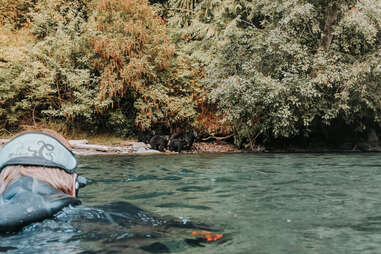“It’s seldom we would see a bear, but not impossible,” Roger McDonell told me in early September, just a few days before we stuffed ourselves into thick wetsuits, strapped snorkeling masks to our faces, and lowered ourselves into the rushing, 59-degree water of the Campbell River on British Columbia’s Vancouver Island. We were there to take our autumn activities to the next level, forgoing the region’s annual fall leaf peeping for a more active autumn pastime: a salmon-peeping river snorkel.
“It’s more likely just to see harbor seals,” McDonell added.
Fortunately, he spoke too soon. Less than a minute after entering the water, before I had even identified the sparkling silver blobs around me as a kaleidoscope of pink, coho, and chinook salmon, brownish shapes emerged from the forested river bank no more than 20 feet away. It wasn’t just one bear, but four: a mom with three rare triplet cubs.
Like my own small group of snorkelers, the bears were drawn by the siren call of the river’s migrating salmon, clumsily slapping at the water in an attempt to beach a fish. I felt just as clumsy, especially compared to the salmon. They elegantly twisted and turned among moss-covered boulders and rocks as I struggled to keep my buoyant body from getting carried away with the current. The whole display was like a choreographed dance set to the music of the river, an annual performance by the 800,000 or so salmon that migrate upriver each year.
For the next 30 minutes or so, we bobbled through rapids and flew Superman-style through the Campbell River, floating past schooling salmon, many longer than my arm. At the surface, you’re dodging untethered globs of moss and the occasional floating fish guts. But look down, and it’s all salmon, all the time. While they’re pink and colorful on land, underwater, they dart by in shades of sparkling blue, silver, and white, though their effective camouflage makes them nearly impossible to spot from the surface. Generally, they’ll dash away before you make contact—but not before the occasional curious salmon tries to go eye-to-eye with you, seemingly pondering why this ungainly interloper is floating between them and their final destination.
It makes sense that this adventure would take place in the city of Campbell River, sometimes dubbed the “salmon capital of the world,” and the de facto destination for autumn salmon peeping. While some remote Canadian properties like Clayoquot Wilderness Lodge, Bella Coola Eagle Lodge, and Bear Claw Lodge offer fall salmon snorkeling as an activity for guests, Roger McDonell, owner and captain at the OceanFix.ca Dive Center in Campbell River, says he doesn’t know of any other operators offering a similar experience. He says it started in the 1970s, when members of area scuba diving clubs decided a river snorkel would be fun; the huge numbers of salmon were a happy surprise. Now, it’s become a bit of local rite of passage around these parts of British Columbia, and OceanFix offers guests one of two options: guided adventures or gear rentals, which include the snorkel and mask, fins, and 7-millimeter wetsuit (the thickest available, both for warmth, and to provide enough buoyancy to ensure you bounce and bob like a pool raft through the river’s small rapids).
McDonell says most people with any kind of snorkeling experience should be fine going on their own, especially as the OceanFix provides a map and a thorough briefing of what to expect. Though salmon are rampant around British Columbia, not just any river is suitable for snorkeling. It needs to be shallow and slow-moving, and it also needs to have an exit point, which rules out many rivers bookended by dense forest or sheer rock walls. My route took no more than 25 minutes to float, and McDonell says enthusiastic visitors will often do it two or three times in an afternoon.
At the end of my float, I asked McDonell about the environmental impact of sending a human wildly flying down a river usually reserved for salmon and seals. In McDonell’s estimate, it has no more impact than the fishermen—or bears—prowling the shores, especially because it’s not something people do in the hundreds. We were the only ones in the river when I floated in early September, with most observers choosing to view our antics from dry land. “The salmon definitely avoid the snorkelers, probably because we resemble one of their natural predators, harbor seals,” says McDonell. “So the impact of our brief encounters should be a low factor in their overall arduous journey upstream.”
Want more Thrillist? Follow us on Instagram, TikTok, Twitter, Facebook, Pinterest, and YouTube.










Comments